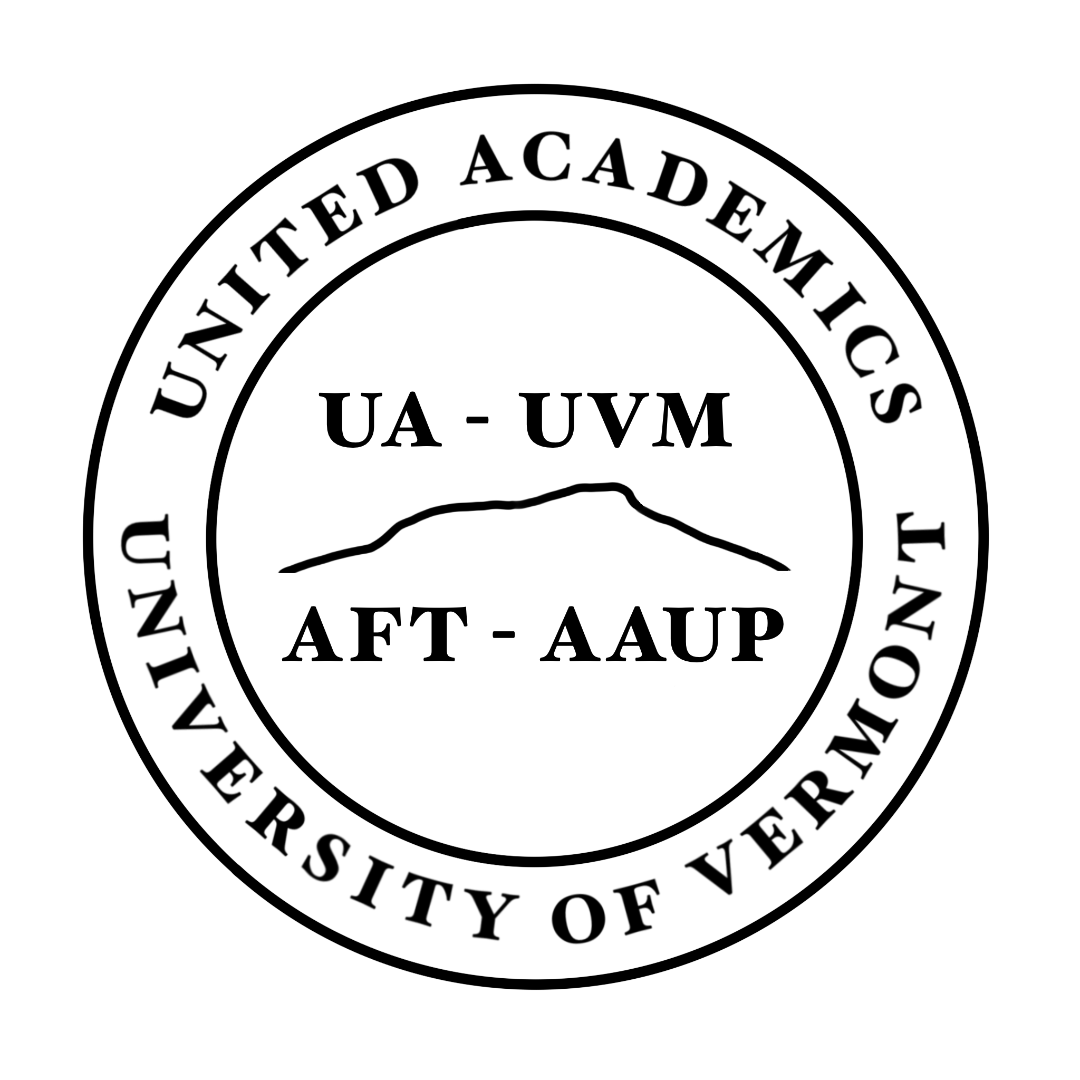UNITED ACADEMICS at the University of Vermont
Why do we need a faculty union?
Notes from a talk to new faculty on 8/21/17
by UA President Tom Streeter, thomas.streeter@uvm.edu
Faculty Unions are Faculty Governance
In 1900, an economist named Edward Ross lost his job at Stanford University because Mrs. Leland Stanford didn't like his views on immigrant labor and railroad monopolies. In response, in 1915 Arthur Lovejoy, a philosopher at Johns Hopkins, and UVM alum John Dewey called a meeting to form an organization which would ensure academic freedom for faculty members. This occurred at a time when the notion of "academic freedom" was still a novel concept, and it resulted in the birth of the American Association of University Professors (AAUP). In the 1930s, many more joined the organization, including the likes of Albert Einstein, in order to promote the principle of academic freedom in universities in the US.
The 1940 Statement of Principles on Academic Freedom and Tenure, produced jointly by AAUP and the American Association of Colleges and Universities, enshrined the basic system of hiring and promotion that governs practically all research universities and most colleges in the U.S, from Harvard to branch campuses of the University of Oklahoma. This is the system of peer review, promotion, and tenure that defines the life of academics throughout the country.
Faculty unions give those protections more legal teeth while also extending faculty power to collective bargaining over things like salary, benefits, and grievance procedures.
What does United Academics do for faculty?
· Salaries are better when we are unionized. Through the 1990s, before there was a union, the University of Vermont faculty salaries fell to the bottom quintile of public research universities. Once we were unionized, salaries rose to be closer to the average of public research universities, particularly for lecturers, assistants, and associate professors.
· Also, salaries better reflect professional accomplishments: (I’ll use a personal example — not because I’m particularly interesting, but just because I don’t want to talk about other people’s private information.) When I got tenure and published a book that won a national award, I received only sub-inflation raises, essentially a cut. The Dean said “there’s no money.” With a contract, that can’t happen anymore because it guarantees minimum promotion bumps for tenure and promotion (between 6 and 10 percent, roughly), including for lecturers.
· Lecturers have more job security (e.g., multi-year contracts) and opportunities for promotion and sabbaticals.
· It ensures that procedures for judging merit, including promotion and merit raises, are fair, consistent, and transparent. In negotiations over salary, we work to ensure that salaries are competitive with national standards in respective disciplines. The union does not judge merit, nor does it try to make salaries uniform.
How does the union work?
There are three basic ways in which the union supports the interests of faculty and teaching and research at UVM.
• The contract is negotiated between UA and UVM’s administration every three years. It contains 140+ pages of rules, governing everything from salaries to reappointment procedures and more. Like all contracts, it reflects discussions and compromises between both sides.
• UA encompasses two bargaining units: full time (~700 faculty, excluding medical faculty) and part time (~150 faculty).
• The Contract Administration Committee deals with grievance procedures and with making sure the contract is enforced. This is an essential part of ensuring that UVM operates professionally and fairly.
(Email: contract@unitedacademics.org.)
• UA engages in a number of public-facing activities, including working with the Faculty Senate, the Vermont legislature, and more.
How does UA make decisions?
• Faculty run UA via democratic processes. The President, Vice President, Treasurer, and so forth, are elected according to UA’s bylaws, as are the members of the Delegates Assembly which has representatives from departments and programs.
• There are other bodies, such as the Civil Rights Committee, which consider responses and appropriate actions regarding issues that involve university policy, social justice, and more.
Why should I join UA?
• It’s about having a voice: When you join United Academics, you have a right to involvement in decision making, including the contract, and serving on decision-making bodies. As a UA member, you are assessed membership dues of 1 percent of your salary. (If you do not join, you are charged an agency fee of .82 percent of your salary – a feature supported by Vermont law, intended to address the “free rider” problem – and are still represented by UA in the contract, grievances, and related matters.)
• Membership gives us power: Each new member strengthens UA’s ability to represent faculty, secure better salaries and working conditions, and promote quality teaching and research at UVM.
UA Resources:
- For a question or complaint that might be related to the contract, feel free to send a confidential email to contract@unitedacademics.org.
- To contact officers and staff: http://www.unitedacademics.org/officers-and-staff/
- To become a member of UA: http://www.unitedacademics.org/join-us/
- To consult the current contracts: http://www.unitedacademics.org/current-contracts/
- For members to catch up with the current state of the contract negotiations:
http://www.unitedacademics.org/bargreports/
(If you need a password, email: pgannon@unitedacademics.org.)
- For general information about UA: http://www.unitedacademics.org/what-we-do/
